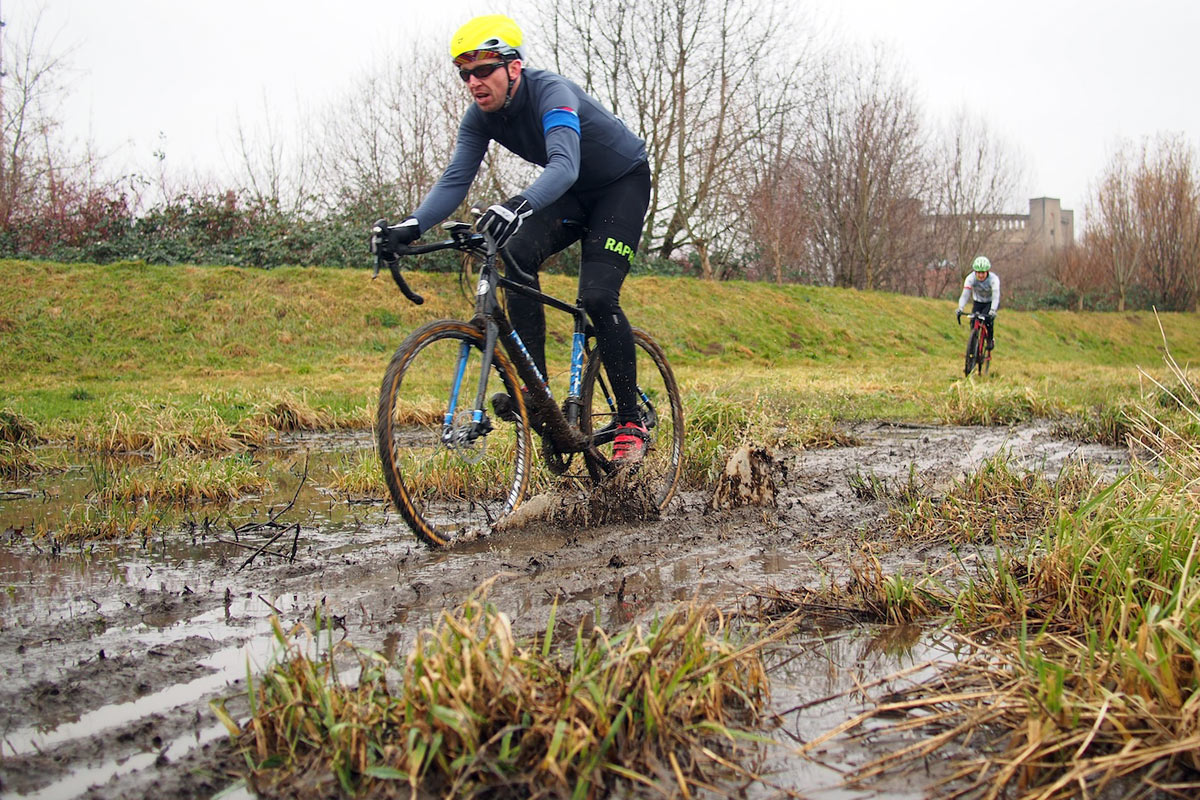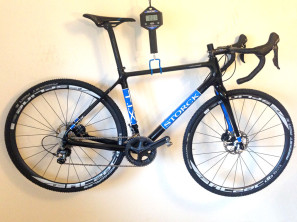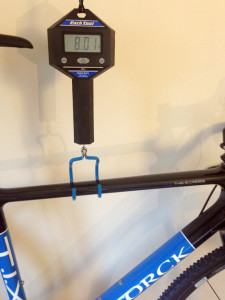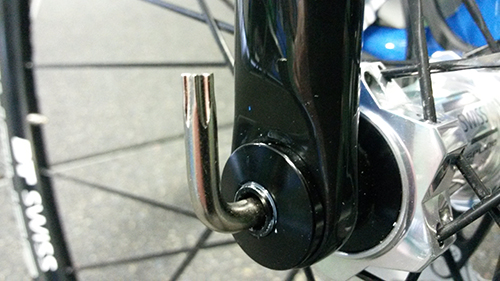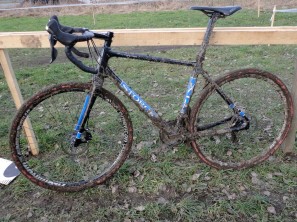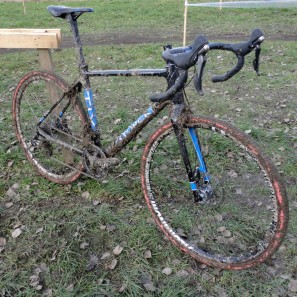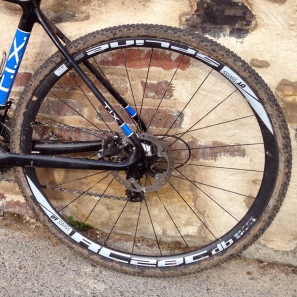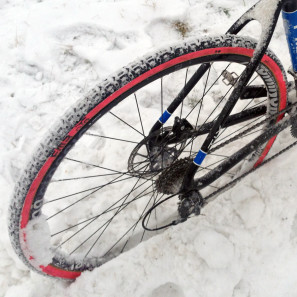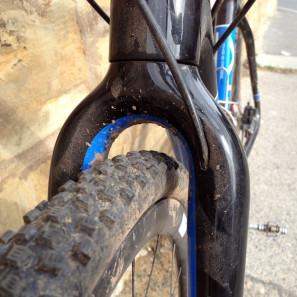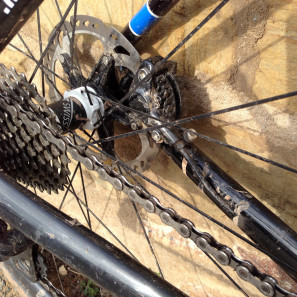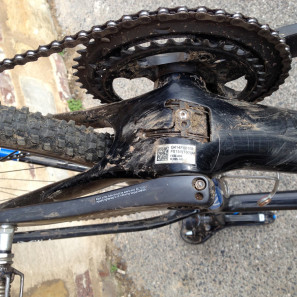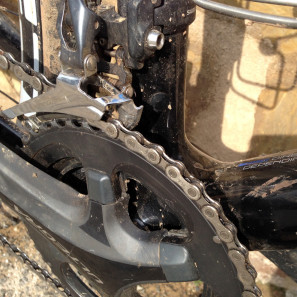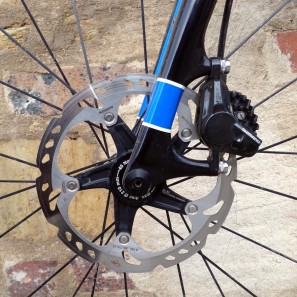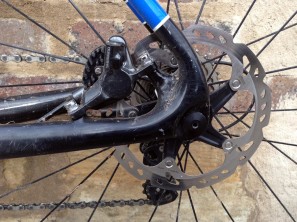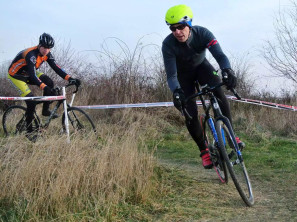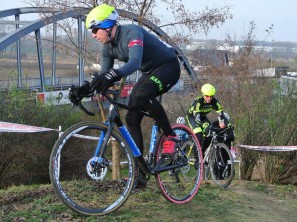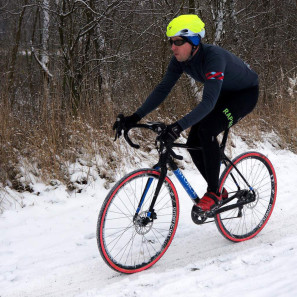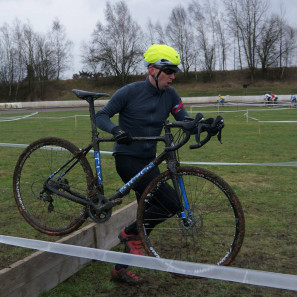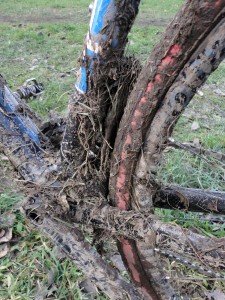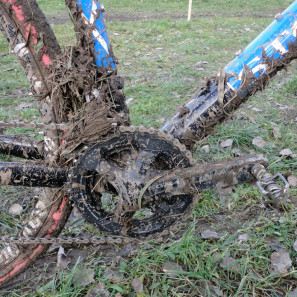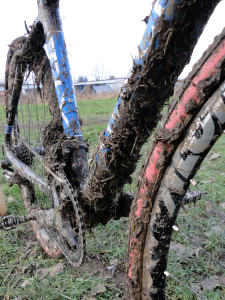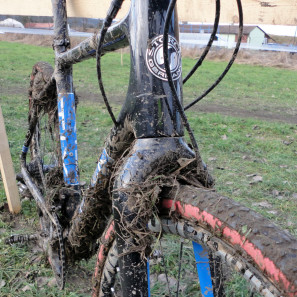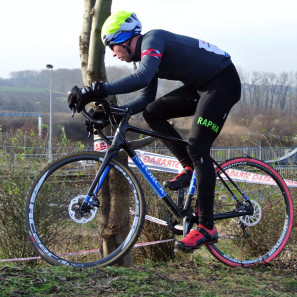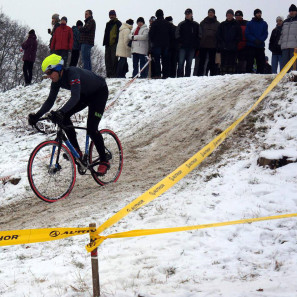After having profiled the new cyclocross bike from Storck last fall at Eurobike we were excited to have an opportunity to conduct an extended review. Being quite well known in Europe for producing very light bikes that perform well, we were curious how a light offering from them might handle the mixed type of terrain thrown at a cross bike; how it would perform on the race courses, and how it might ride and survive once cross season had finished. In talking with several people on the Storck team from the company director to the head of marketing, they liked the idea of a long-term test and lent us a bike for the second half of our winter race season, and to ride into the first hints of spring.
This first, of a two-part review, will look at the bike exclusively from a cyclocross perspective. The T.I.X. has several unique features that can end up as pros or cons depending on how you use the bike, so we’ll try to give you a good idea of what to expect. Storck describes it as a bike for ‘cross terrain’ and then talks about riding it on your ‘favorite cross-country tours’ so we were curious to put it in an intense cyclocross racing atmosphere, and then we’ll follow it up in a month or so with a look at riding the bike on more mixed surface road and trail rides.
Join us after the jump to see how the T.I.X. stands up to the sand, mud, and snow of cross racing…
Weights & Spec
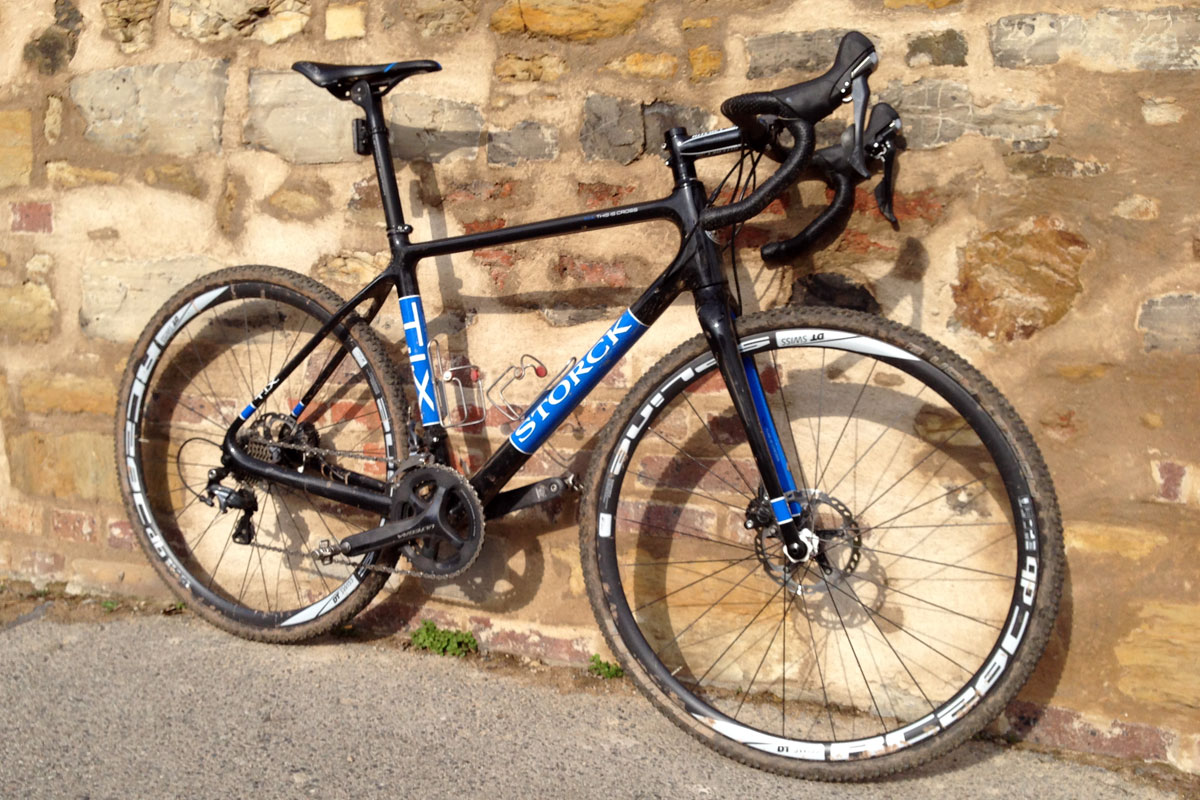
The T.I.X. which debuted at Eurobike wasn’t quite ready for the 2014-15 cyclocross season. With availability limited until around November/December of last year, we were first able to race the bike in our pre-Christmas/Kerstperiode races, which were some of the most brutally cold, on hard frozen courses and through ice and snow. Coming to us mid-season, we didn’t have time to casually adjust to the bike before jumping on it at full speed, so it got raced pretty much from day one.
Throughout the season we raced on two extremes of bikes: a few everyman steel bikes on which we tested drivetrains, wheels, tires, and cockpits from several manufacturers; and on the other hand a couple of elite level made-in-Germany carbon fiber race machines. Replacing the Stevens Super Prestige Disc that we raced in the first half of the season (and on which Mathieu Van der Poel won the World Championships), the Storck T.I.X. had big footsteps (tire tracks?) to fill. We did however transition fairly smoothly from one carbon bike to the next, partially aided by the fact that both bikes were built up with the same Shimano new Ultegra RS685 hydraulic disc-brake/mechanical shifting groupset (that I added to my wish list after these two bikes) and a slightly shallower clincher version of the same DT Swiss RC Spline wheelsets.
The bike came set up with the Ultegra group and RC28 Spline C DB wheels, plus some Storck-branded cockpit parts: house brand two-bolt carbon seatpost and flat-top carbon bar, aluminum stem, and Selle Italia SLR saddle. For our ideal fit and to get it on the trail, we swapped in a Ritchey 4-Axis stem and a pair of Crankbrothers Eggbeater pedals. Our test bike was a size M, which with the dramatically sloping top tube geometry equates to a 54cm effective top tube and 38cm of frame reach.
The frameset with fork, headset, seat post clamp, and thru-axles retails for 1,800€, with the complete Ultegra mech/hydro bike as tested at 3,700€. Frame weight is a claimed 940g. We didn’t strip the bike down to confirm, but with a ready to ride weight of just 8.01kg with a pair of 280g eggbeater pedals (a quick shout-out of thanks to Progress Cycle, who keeps us shod in Crank Brothers pedals and helps us out with servicing parts after a season of cross racing) it is a full 1/2 kilo lighter than the similarly priced and equipped Stevens that preceded it in our test (which had a lighter wheelset.)
The bike also interestingly includes a small T25 torx wrench which stores with the help of a couple of rubber o-rings in the driveside hollow of the front axle. It is needed to remove either thru-axle to change a tire or wheel, so makes a nice addition; plus it also works for many other adjustments on the bike: stem, seatpost, saddle, derailleur cable clamp, rotors, and disc caliper.
Product Details & Tech
With thru-axles for cyclocross there are plusses and minuses. The Storck uses 100x9mm in the front and 135x10mm rear thru-axle dropouts. I guess the theory behind the selection was that as the smallest of the thru-axle standards this would be the lightest, and could probably work with more road-oriented hubsets. In practice it meant that it was harder to find compatible wheelsets since this standard is less common. Of course the DT RC Spline wheels are available in any of their depths, but we were also lucky to see that the excellent American Classic Aluminum Tubulars we have been testing could have their axles quickly swapped out to work too.
The frame’s 100x9mm/135x10mm thru-axles have no dropout slots to guide the wheels in place, only the smooth inner surfaces of the frame/fork at the dropout. After only 2 or 3 front wheel changes, we got to the point where we could line up the front axle and hub by eye every time. The rear was a different story, since even the tension of the chain when on the littlest cog of the cassette pulled the hub out of line with the rear axle as it was inserted. We got better with it, but it still requires an expert (lucky?) touch while changing a wheel in the middle of a cold, muddy field. Another issue is that each time you change the wheels you really need to apply fresh grease to the aluminum axle threads and small loose nut that you are trying not to drop in the mud. Plus, since the disc brake rotor goes into the caliper before the axle is in place, this twisting is also trying to bend the rotor, which we believe resulted in some rotor rub on one occasion. While it works fine in our workshop and results in a lightweight and stiff interface, we still curse it every time we have to change a wheel in the pits or trailside.
The bike comes with a clincher wheelset, which we feel is a bit odd for such a lightweight and capable race bike. Sure clinchers are more versatile, but these DT wheels are road wheels not cross wheels and with just a 15mm internal width, they made every cross tire we tried narrow and more of a light bulb shape. They even have a label under the clearcoat that lists a max tire width of 23mm?! Plus, the tubular version of the same depth wheels also is 21mm wide outside and makes a nice cyclocross race wheelset. Then, remember that they are more than 100g lighter and about 240€ cheaper, meaning you could walk away for less money with the best handmade tubulars on the market to boot. This bike really deserves tubulars or at least a more appropriate clincher wheelset with at least a 19mm internal rim width (even if that is a cheaper aluminum setup.)
The frameset is made up of some dramatic tubing shapes (almost every tube is tapered with sometimes the largest tube diameter in the middle of the tube), with a 1.125-1.5” integrated headset and Storck’s own disc-only tapered Stiletto T.I.X. fork. The oversized tubing is apparently proportionally size-specific, with our medium downtube measuring up to 62mm wide and 47mm deep. The top half of the bike – seatstays and toptube – also has flattened profiles to make up for the stiffness of the large seattube, downtube, and tall chainstays at the bottom bracket. The frame itself is completely carbon fiber including a 41×86.5mm PressFit carbon bottom bracket shell and headset. It does have an aluminum bolt-on replaceable derailleur hanger and two sets of water bottle bosses. The frame uses a 31.6mm diameter seat post and includes a 34.9mm clamp. Both shift cabling and brake hoses are all internally routed, with electronic or mechanical ready stops.
The internal rear brake line enters at the downtube, snakes around the bottom bracket, and exists on the inside of the chainstay. The fork has internal routing too, that didn’t seem to collect more debris than the rest of the fork. The ports for the hoses are not sealed in anyway, but we never noticed water infiltration being an issue during several wet cross races, perhaps because the fork opening drains directly out of the lower opening and the frame draining out the open BB port?
Derailleur routing is also through the downtube, meaning that it exists through an open port under the bottom bracket, and the front shift wire slides though a guide exiting a rounded shelf behind the bottom bracket for a traditional bottom-pull derailleur (and is also Di2-ready.) While the bike did collect mud and grass here in the worst races, the bigger issue was build-up on the extended lever arm of the new 11speed Shimano front derailleur. We would have preferred there to be no shelf behind the bottom bracket, and think that Storck could engineer their design and layup to eliminate it while maintaining good stiffness, especially with the thru-axle rear. That being said this setup was better than any pulley design, and really only was a limiting factor in one race this year that perfectly balanced heavy mud and loose grass.
Like on a lot of cyclocross bikes we see, the T.I.X. is also only compatible with 160mm or larger rotors. From a cyclocross race perspective (and even more so from Storck’s focus on light weight) we can’t see how this makes sense. Disc brakes are incredibly powerful; cross tire contact patches are relatively narrow (compared to mountain bikes using the same size rotors); cross race courses are notoriously loose and slippery; braking duration in cross is very low; and cyclocross race speeds are relatively slow. Please cyclocross bike builders, give us the option to put 140mm rotors on our bikes for cross racing and the better modulation and lighter weight they offer.
</rant>
Ride Impressions & Review

race photos courtesy of Zdeněk Eminger and Barbora Davidová
That stiffness is key for cross racing is indisputable. With continuous accelerations, twists and turns, and then more sprinting all at pretty much max heartrate, power transfer is critical. The T.I.X. managed to turn every bit of effort we could put into the pedals into forward motion. And it did so without beating the rider up too much, so they could withstand an hour of suffering even on frozen and rutted race courses.
One thing we felt lacking was the ease of swapping wheels back-and-forth. At the amateur level, very few of us can afford to have multiple multi-thousand $/€/£ race bikes, with one waiting in the pits. We need to be able to put a set of wheels in the pit, and run for a wheel change if we flat or otherwise have a mechanical (see for example the photos above where I ran over a sharp object and flatted just before a race). We want to quickly swap wheelsets to changing conditions. The thru-axles of this bike make that a chore. The lack of dropout slots to guide the thru-axles into place is really our only major gripe against the frameset. It truly is a pain, and something we hope will be updated in future versions.
Other than that we had great luck with the Storck. Putting a 120mm stem on the Medium gave me (185cm tall) a good fit to race with no issues. The bike did its job well when there was ample traction on frozen ground, on ice and hardpack snow, and through greasy mud and wet grass. Handling was quick and cornering was stable and predictable. The sloping geometry still left enough room in our medium test bike to shoulder it for runups, and the flattened top tube was easy on the hand for suitcasing it.
The disc brakes also performed without flaw. I don’t feel like more braking power is really needed in cross, but the extra confidence of knowing I could wait in snowy or muddy conditions to the last second to brake made me faster through the turns. It was kind of the same thing in a snowy race with barriers laid out in an S turn. By riding the barriers on the Storck I didn’t actually go faster than if I got off and ran, but knowing I didn’t have to worry about clipping back in or sliding on foot, made me push the approach harder and distance my competition on the exit. A lot of cyclocross is confidence and the T.I.X. is confidence inspiring.
The one time we ran into trouble on the bike was in a race covered in slick mud and a grass field soaked by thaw. The first couple of laps weren’t a problem, but as more and more grass and mud built up on the front derailleur arm it got exponentially worse. Mid way through the race, I was happy to drop the Storck in the pit and hop on a second clean bike. Looking back on the bike post-race I saw that that giant downtube was like a fender blocking/catching most of the mud sprayed up. The chainstays also carried a good bit of mud, but it never really clogged. The derailleur though was a mess.
Unfortunately I didn’t have a mechanic cleaning bikes in the pit, but that was pretty much the only thing that would have kept a bike mud-free (and light.) The bike I finished the race on had a SRAM 22 drivetrain and no chainstay bridge, but instead a front derailleur cable pulley. It wasn’t pretty by the end of the race either, and most everyone else racing had problems too. What to take away from that? Well, the new Shimano front derailleurs are mud and grass magnets. It is too bad, as they shift so well, and I’m not sure if the Shimano top-pull CX derailleur is compatible with the new shifters? In any case, Campy, SRAM, and Microshift front derailleurs do suffer just a bit less from this cyclocross mud issue. This was the muddiest race of the year. We usually get one or two this bad every season, and the only racers who truly don’t suffer are the singlespeeders (and they just suffer differently.) On the T.I.X. you could always avoid it by going 1x, or just suck it up and keep pedaling.
The jumpy acceleration of the bike is what really stands out after a couple months of racing. While the bike doesn’t have the vertically stiff feel to it that many cyclocross race bikes do, the thru-axles, wide downtube and bottom bracket, plus the large chainstays combine to deliver excellent power transfer and rapid accelerations. It was surprisingly easy on this bike to be slogging along feeling like you were dead, then to just stand up and sprint for a few good pedal strokes. It felt easy to get back up to speed, and on several occasions, I opened up a gap that my competitors couldn’t seem to close. Maybe part of that was late season form (and the fatigue of others), but I feel like the T.I.X. brought a lot of late season improvements in my race results and helped me move from the first half of the season where I was ranked around 15th overall to a final series placing inside the top ten. What remains in my mind is a feeling of going fast, not a bad image for a race bike to leave.
